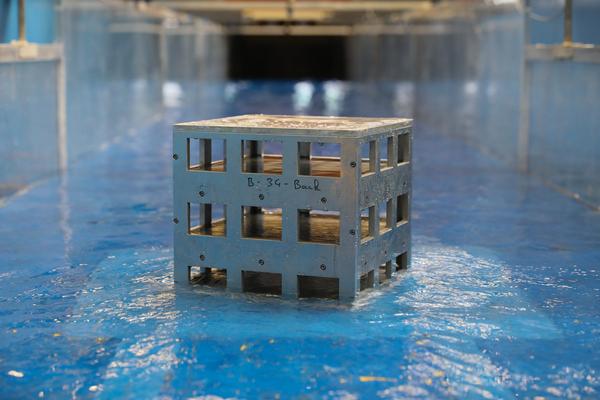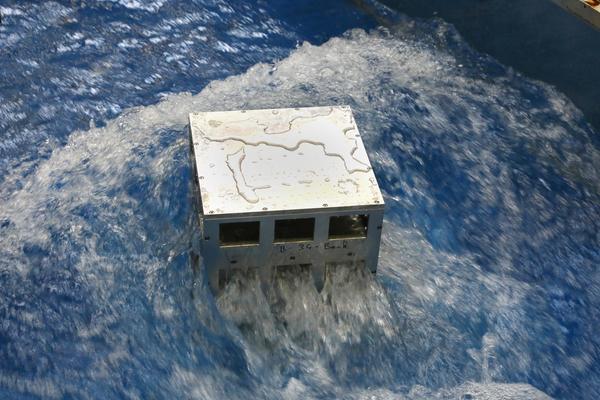Sacrificing ground floors can save lives

Davide Wüthrich et Anton Schleiss dans le canal de test du Laboratoire. © Alain Herzog / EPFL 2018
Disasters like tsunamis, hurricanes and dam failures are rare but can have devastating consequences on a country. A thesis at EPFL has shown that appropriate construction methods can substantially reduce the impact of such catastrophic events.
Davide Wüthrich, a PhD student at EPFL, has just finished his thesis on methods for reducing the damage caused when a wave hits a building. He found that creating large openings in the lower floors can lessen the impact of a water surge significantly. This can be especially important for houses located on riversides, lakesides and ocean fronts. Never before has such an architectural approach been applied to the problem of wave damage. A Japanese Research Agency has already shown interest in Wüthrich’s research and would like to try to model numerically his findings. A Master’s project at EPFL will expand further on his work. The public defense of his PhD will take place on 9 March at EPFL.
 “We found that there is a linear relationship between the amount of openings in a building’s architecture and the reduction of a wave’s impact. For instance, if a building’s façade has 60% openings – due to doors and windows, for example – then the impact of a water surge will be 60% lower. And according to our calculations, a building needs to have at least three to five stories, depending on the size of the wave, for its occupants to be able to safely escape to its roof,” says Wüthrich. He believes that civil engineers can go further in incorporating such data into the design of waterfront structures – as they are already required to do under building codes for structures exposed to earthquake risks. “Building codes already take into account the horizontal forces that can impact a structure, but only for the short time periods of earthquakes. However, a tsunami generates a horizontal load that lasts much longer,” he adds. Some countries’ building codes already include specifications that would mitigate the impact of water surges. But not Switzerland’s.
“We found that there is a linear relationship between the amount of openings in a building’s architecture and the reduction of a wave’s impact. For instance, if a building’s façade has 60% openings – due to doors and windows, for example – then the impact of a water surge will be 60% lower. And according to our calculations, a building needs to have at least three to five stories, depending on the size of the wave, for its occupants to be able to safely escape to its roof,” says Wüthrich. He believes that civil engineers can go further in incorporating such data into the design of waterfront structures – as they are already required to do under building codes for structures exposed to earthquake risks. “Building codes already take into account the horizontal forces that can impact a structure, but only for the short time periods of earthquakes. However, a tsunami generates a horizontal load that lasts much longer,” he adds. Some countries’ building codes already include specifications that would mitigate the impact of water surges. But not Switzerland’s.
Wüthrich’s recommendations would apply to buildings exposed to a wide range of natural disasters: tsunamis; storm surges; dam failures; impulse waves caused, for example, by landslides into lakes; and tidal bores, which occur when the leading edge of a tide forms a wave that travels up a river. He studied these phenomena in the Bordeaux region, but they also occur in China and the UK, for instance. “The physical mechanisms are very similar; they all produce waves of almost the same size – around 10 to 30 meters high. So our findings are relevant in a variety of circumstances,” says Wüthrich.
Experimentalresearch
Although many EPFL labs are working on sophisticated algorithms and big data, some still rely on good old-fashioned experimental research, due to the complexity involved in many physical processes. In civil engineering, that’s the case at the Laboratory of Hydraulic Constructions (LCH) headed by Professor Anton Schleiss, where researchers work on scale models of water infrastructures. Wüthrich performed his experiments on a 15.5-meter-long canal with a control room above it, for data acquisition. At one end of the canal lies a water basin and valve that can be used to generate large waves similar to storm surges and tsunamis. A small metal box with removable openings sits in the middle of the canal, to simulate an exposed building.
 Empirical equation
Empirical equation
Wüthrich carried out over 350 different experiments on his test canal, each time changing the number, height and/or size of the openings – which correspond to the number of doors and windows that can attenuate the impact of a water surge. The idea is to find the configuration that would enable a structure to resist the shock. Wüthrich also wanted to identify what type of architecture would allow building occupants to safely ride out a surge on the building’s roof – an important consideration in countries subject to such calamities.
Before embarking on his experiments, Wüthrich studied the hydrodynamic behavior of waves in the absence of a structure, and the likelihood that a structure’s openings could be blocked by floating objects such as cars, boats and furniture. He also considered the benefits of letting the water run over a building. Once the experiments were completed, he used the data to develop an empirical equation that can estimate the forces generated by a wave when it hits a building, based on the size and shape of the building’s openings and the wave’s hydrodynamic properties (like height and speed). He found that openings on the lower floors are the most effective at dampening the impact and reducing upstream water levels.
Heightened awareness
So why did Wüthrich decide to study phenomena that occur so infrequently? For one thing, they could happen right here in Switzerland – witness the massive impulse wave in Lake Geneva in 563 that was triggered by a mountainside sliding into the water. But more generally, because people have become much more aware of the issue since the tsunami that hit the coasts of the Indian Ocean on 26 December 2004 – a disaster that took 280,000 lives and caused some $11 billion in damage. Likewise after the 2010 tsunami in Chile. Those tragedies spurred scientists into action to develop preventive measures. “Research on tsunamis picked up since 2004 after a lull of several years, with publications peaking in 2010. The 2011 tsunami in Fukushima [which killed 16,000 people and caused $226 billion in damage] gave scientists an opportunity to test their new theories. But despite the proliferation of research, we still don’t have a good overall picture. Scientists seem to focus just on measuring forces instead of suggesting new building architectures,” says Wüthrich.
Davide Wüthrich, “Extreme hydrodynamic impact onto buildings,” supervised by Prof. Anton Schleiss Dr. Michael Pfister, February 2018.
PUBLICATIONS
Wüthrich, D., Pfister, M. Nistor, I. and Schleiss, A.J. (2018. “Experimental study of tsunami‐like waves on dry and wet bed generated with a vertical release technique.” ASCE Journal of Waterways, Port, Coastal and Ocean Engineering (accepted for publication). (DOI: 10.1061/(ASCE)WW.1943-5460.0000447)
